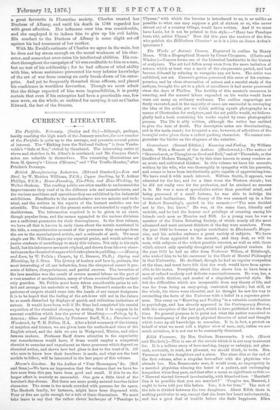British Manufacturing Industries. (Edward Stanford.) — Iron and Steel, by W. Mattieu
Williams, F.C.S.; Copper Smelting, by T. Arthur Phillips, F.C.S.; Brass-Founding, Tin-Plate, and Zinc-Working, by Walter Graham. The rending public are often unable to understand the improvements they read of in the different arts and manufactures, and the various machines and operations they see exhibited in the industrial exhibitions. Handbooks to the manufactures are too minute and tech- nical, and the notices in the reports of the learned societies are too scientific. The volumes of the present series are intended to supply the desideratum. The information required is to bo given in an exact, though popular form, and the names appended to the various divisions are a sufficient guarantee for their thoroughness. In the first volume, we have all that is known in early times about the metals mentioned in the title, a comprehensive account of the processes they undergo from the ore to the manufactured article, and a rationale of each. We must single out Mr. Williams's paper for especial praise, and would advise all junior students of metallurgy to study this volume. Not only is his style lucid, but his inferences are most original, and drawn from his own obser- vations on the chemical changes which take place in puddling.—Llostery and Lace, by W. Folkin ; Carpets, by C. Dresser, Ph.D.; Dyeing and Bleaching, by J. Sims. The history of hosiery and lace is, perhaps, the most interesting of all our industries, from the chequered career it pre- sents of failure, disappointment, and partial success. The invention of the lace machine was the result of severe mental labour on the part of a vast number of mechanicians, many of whom received insanity as their only guerdon. Mr. Felkin must have taken considerable pains to col- lect and arrange his materials so well. If Dr. Dresser's remarks on the patterns of carpets should come into the hands of our carpet designers, it is to be hoped that the feeling of the art-lover will not in the future be so much disturbed by displays of garish and ridiculous imitations of nature. It would have been well if Mr. Sims had completed his careful exposition of the chemical changes, by stating that it is oxygen in its nascent condition which has the power of bleaching.—Pottery, by L. Anions ; Glass and Silicates, by Professor Barff, M.A.; Furniture and Woodwork, by T. H. Pollen, M.A. After a brief summary of the history of majolica and faience, we are given here the methods and vices of the English school, and the debt we owe to Wedgwood, Minton, and other famous makers. Professor Barff draws attention to the superiority our manufactures would have, if firms would employ a competent chemist to examine and experiment on those processes which depend on chemical action, and shows how bad glass is due to the want of it. All who care to know how their furniture is made, and what are the best models to follow, will be interested in the last paper of this volume.


































 Previous page
Previous page